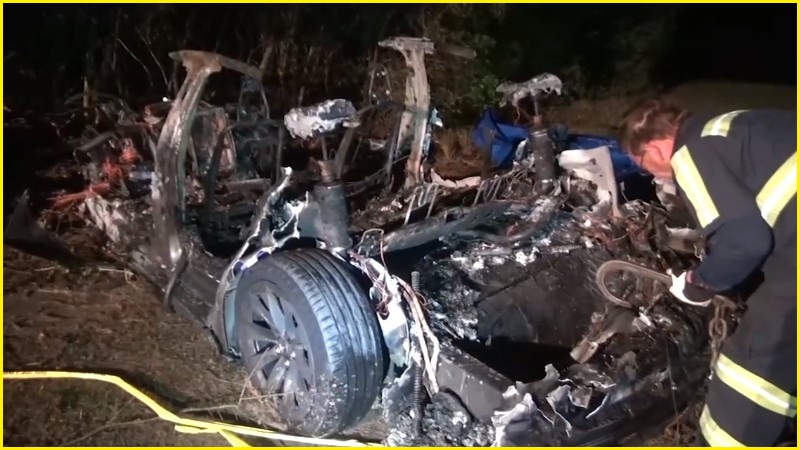Two people have died after a Tesla car ran off the road, with the authorities saying “there was no-one driving” the vehicle at the time of the accident.
The tragic crash will place further scrutiny on Tesla and its Autopilot driver-assistance technology, which automates some highway-driving tasks.
Despite Tesla maintaining that drivers still need to have full attention while using Autopilot, the technology has been criticised for giving owners room to abuse the system, with a number of crashes under investigation.
On Saturday night in Spring, Texas – a suburb of Houston – a Tesla car travelling at high speed failed to negotiate a turn, went off the road and hit a tree.
The car subsequently caught fire, which took firefighters four hours to put out as the lithium ion batteries kept reigniting
The bodies of two men were found in the car, one in the passenger seat and one in the backseat, authorities told the media.
They are believed to be two friends: a 59-year-old doctor and a 69-year-old engineer. The men have not been named.
Harris County Precinct 4 Constable Mark Herman said it appeared likely that there was no-one in the driver’s seat or anyone operating the car at the time of the crash.
“They are 100 per cent certain that no one was in the driver’s seat of the vehicle at the time of impact,” Herman said.
“They feel very confident just with the positioning of the bodies after the impact that there was no one driving that vehicle.”
It’s currently unclear whether the Autopilot feature was in-use in the Tesla car at the time of the crash.
Tweeting earlier today, Tesla CEO Elon Musk said the data logs for the crashed car show Autopilot was not enabled and did not have FSD (Full Self Driving) mode.
“Moreover, standard Autopilot would require lane lines to turn on, which this street did not have,” Musk added.
The feature can complete some tasks automatically for a driver, such as keeping the vehicle in its lane at a safe distance from other cars, and changing lanes.
Despite the ‘Autopilot’ name, Tesla said it does not make a car autonomous, and it requires the driver to have a hand on the steering wheel at all times.
The feature is now standard in all new Tesla vehicles.
The National Highway Traffic Safety Administration is investigating Autopilot’s role in more than 25 crashes involving a Tesla car, including many where these vehicles have crashed into emergency vehicles that were stopped on the side of the road.
In January this year, Musk said he was “highly confident the car will be able to drive itself with reliability in excess of humans this year”.
The batteries in the Tesla cars are also likely to come under scrutiny, with reports it took firefighters four hours and 120,000 litres of water to put out the blaze following the recent fatal accident.
According to the reports, the firefights also actually had to call Tesla to work out how to put out the blaze.
There have been a number of fatal accidents involving Tesla vehicles in recent years, many involving the Autopilot feature.
In early 2020 there were two fatal crashes on the same day involving Tesla cars.
In California, a Tesla Model S sedan ran off a freeway and through a red light at high speed, hitting another car and killing two people in that vehicle.
Also on that day, a Tesla Model 3 hit a parked fire truck on a freeway, killing a passenger in the Tesla.
In 2018 there was another fatal crash involving a Tesla car, which was operating on Autopilot. This incident occurred in Mountain View, California, with the car crashing head-first into the safety barrier section of a road divider. The driver of the car died from injuries sustained in the crash.
In 2017 it was found that an “over-reliance” on Autopilot played a major role in another fatal crash which saw a Tesla Model S sedan crash into a truck that had turned in front of it without giving way.
The National Transportation Safety Board found that the Autopilot feature had allowed the driver to not pay proper attention to the road, but that the accident was ultimately down to human error.










